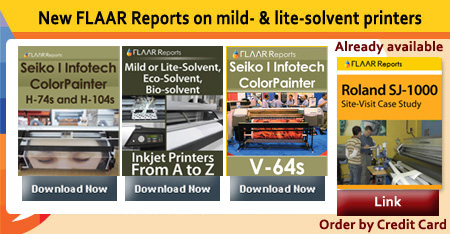Seiko IP-4500 Mk-II and 4010 Mk-II for outdoor signs, posters, banners.
Seiko I Infotech IP-4500 Mk-II and 4010 Mk-II produce notably better quality than the previous generation. The Mk-II versions have potential for outdoor signs, posters, and banners.
The original earlier model IP-4500 and IP 4010 Seiko printers which we inspected in person at DRUPA 2000 and other German and American tradeshows in 2001 were poor quality. Whoever writes their advertising slogans includes excessive claims that should be embarrassing. There is no such thing as “unprecedented high speed.” However the ads for the newer Mk-II models seem to be more realistic recently; we will see what the Seiko booth ads claim at SGIA ’03. The company has a capable new manager so things may continue to improve.
We inspected the new Seiko printers at SGIA 2002 tradeshow last year. This report on the SGIA tradeshow by Nicholas Hellmuth is available from FLAAR.
Original Seiko IP-4500 and IP-4010.
Since so many old printers are for sale on e-Bay we maintain reviews even of older printers such as the original Seiko IP-4500 and IP-4010.
At DRUPA 2000 Seiko Instruments exhibited these model printers with Xaar-licensed piezo print heads. The test print they were showing was badly out of focus. Whether this was due to it being a stock photo I have no way of knowing. But if you want to reveal the potential of your printer, better make the effort to select a really nice picture. For this reason FLAAR does not use stock photos or clip art in its tests.
The other problem with the Seiko Instruments wide format printer at DRUPA was the cheap paper. It appeared to be totally without gloss, possibly a coated ordinary paper. Again, possibly because no other paper was ready for the new printheads, or possibly because no ICC profiles were ready. Again, not a very clever idea to reveal all the weak points of your new printer. Part of the problem was that the Seiko Instruments IP-4500 and IP-4010 were clearly unfinished prototypes. At least the company was honest and labeled the machines as prototypes on the product brochure.
All the information we gathered and our conclusions on these Seiko printers are available in four reports: DRUPA 2000, Used Printers, the new “Oil-Based Inkjet Printers” Fast Facts, and tradeshow reports such as ISA. We are considering researching and issuing an entire series on oil-based printer applications. But until this happens, our report on oil-based printers is in the FLAAR series on solvent ink printers.
If you are looking for a printer for outdoor signs, posters, or banners, then you should consider the FLAAR series on printers for these purposes. We cover solvent ink printers and oil-based ink printers, all sizes, as well as UV pigmented inks. Also have updated coverage of UV-curable ink flatbed printers such as Zund, Durst Rho, Sericol Inca Eagle, Vutek flatbeds, and others.
Present and future for oil-based printers.
Oil-based printers never really had a believable spokesperson. Then eco-solvent and lite-solvent printers came out. The first models of eco-solvent suffered from misleading advertising which resulted in some buyers refusing to keep their printers and returning them to the manufacturer (because media was not as low cost as insinuated).
So what is needed now is a comprehensive survey of oil-based technology so that all of this can be put together in its proper perspective. Each ink chemistry and printhead technology is improving; each has its positive features together with its downsides. Just like us humans. Today it helps to look at what applications you need to print, check out what your clients really need, and then see what niches can you enter by purchasing a new printer, especially a printer in a novel technology (such as oil-based ink).
The future for oil-based printers looked dim when XES did not exhibit their ColorgrafX X2 at ISA tradeshow earlier in ’03. Then the ColorgrafX X2 seemed to have been removed or otherwise unavailable on the XES web site. When I tried to find out if the printer division had been cancelled, the main XES receptionist did not even know ColorgrafX existed. But in September the ColorgrafX X2 is back on the XES web site with a note saying XES is now back with Xerox. The European manager for Xerox says the ColorgrafX X2 is readily available in Europe. What we are trying to find out is whether they intend to continue with wide format inkjet in the future?
Dilli shows OmegaJet OJ-62D and D.G.I. offers OmegaJet OJ-62.
Korean inkjet companies Dilli and D.G.I. also have oil-based printers under the OmegaJet OJ-62 and 62D monikers, so clearly they see a market potential.
So stay tuned as the growing FLAAR staff at two universities continue to assist savvy print shop owners and operators with pithy evaluations. This summer we researched and produced an entire series of reports on UV-curable ink flatbed printers. We did the same for solvent ink printers. Now we are tempted to consider a dedicated series combining applications and oil-based printers.
Most recently updated Sept 15, 2003.
Previous updates: Sept. 8, 2003, Sept. 2, 2003, January 20, 2003 after Graphics of the Americas tradeshow.
 |